|
|
Advertisement:
|
|
Intel 6xx Series and 3.73GHz Extreme Edition CPUs |
|
Join the community - in the OCAU Forums!
|
EIST, 3.73GHz Extreme Edition, Test Setup, Temperature
ENHANCE INTEL SPEED STEP TECHNOLOGY (EIST):
EIST is a new feature with the 6xx series, to dynamically increase or decrease the processor clock speed in line with application requirements. The keyword here is "dynamically", because EIST is not working with a fixed temperature scheme like TM2. If the OS reports no or low processor utilization, the multiplier is dropped down to 14 x 200 MHz = 2800 MHz, and subsequently the voltage is adjusted downward. The idea behind this feature is simple: If a task does not need 100% processor power, it will be operated at lower frequencies to keep power dissipation and temperature as low as possible.
Pentium M users are familiar with this technology already. There is however one major difference: The Prescott multiplier can only be dropped to 14x, resulting in 14 x 200 MHz = 2.80 GHz. This is limiting the power conserving impact for lower clocked 6xx series processors, such as the 630 and 640 accordingly. AMD "QuietíníCool" technology allows to drop the multiplier further than that and the Pentium M multiplier can be dropped all the way to 6x, offering a greater power conserving and temperature reduction potential. EIST works when the system is idling and under light load. It does not work when the processor is using full processing power. Unlike Thermal Monitoring 2, Speed Step allows the user to control the process. The user can select the "mobile power scheme" in Windows XP Power Management to enable it.
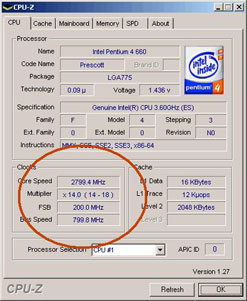 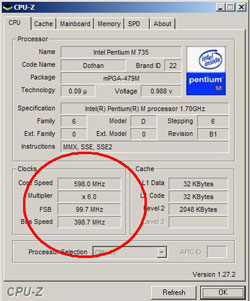
The two CPU-Z screenshots above show, at left, a 660 (3.60 GHz) processor idling at 2.80 GHz with the multiplier dropped to 14x and at right, a Pentium M 735 (1.70 GHz) idling at 600 MHz with the multiplier dropped to 6x.
THE 3.73 GHZ EXTREME EDITION:
The first P4 "Extreme Edition" processors clocked at 3.20 GHz and 3.40 GHz were based on a modified 130nm Northwood core called "Gallatin". They came with a whopping 2 MB L3 cache and offered initially a substantial advantage over a regular P4 Northwood with its meager 512 KB L2 cache. This advantage was reduced somewhat when Intel endowed Prescott with 1 MB L2 cache. The last Gallatin based Extreme Edition was a 3.46 GHz processor running on a 1066 MHz system bus specifically designed to take advantage of Intelís 925XE chipset. The situation has now changed. The just launched 3.73 GHz EE is not any longer Gallatin based but has the same 90nm 2MB Prescott core that is used for the 6xx series. Consequently there is no difference in cache size anymore. Regular 6xx series processors and the 3.73 GHz EE both have the same 2 MB of L2 cache.
Therefore the only difference between the 3.73 EE and regular 6xx series processors is the system bus frequency: The 3.73 GHz EE is running externally at 4 x 266 MHz = 1066 MHz whereas the 6xx series runs at 4 x 200 MHz = 800 MHz. In other words, the Extreme Edition is now nowhere near as "extreme" as it was originally. Our tests will later reveal how much advantage the 3.73 GHz EE still maintains over its regular 6xx series siblings. It also has to be noted that the 3.73 GHz EE is clocked at 14 x 266 MHz. This means that EIST and TM2 cannot work with this processor as 14x is already the minimum multiplier for any Pentium 4 based on the Prescott core. Our 3.73 GHz EE engineering sample sported only a 14x multiplier. The absence of a multiplier higher than 14 once more confirms that there wonít be any Prescott clocked above 3.80 GHz.
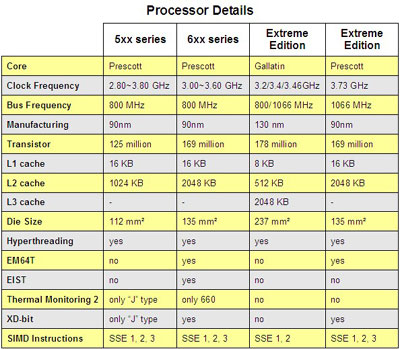
TESTBED AND TEST METHODOLOGY:
The purpose of this review is to evaluate Intelís new 6xx series in terms of features, performance and value for money. In particular the comparison between the P4 650 and the P4 550 is the focus of this article. They are both clocked at 3.40 GHz and any performance difference between them can therefore be attributed to the enlarged L2 cache. The comparison between the 3.46 GHz EE and the 3.73 GHz EE is trickier. They are clocked at different frequencies and although both come with 2 MB cache, itís L3 in one and L2 in the other. Furthermore, as already pointed out, they are based on different cores. Performance differences between them are therefore more difficult to allocate. The A64 3800+ was included in our tests because it is by price and performance close to a P4 650. And the A64 FX55 as the currently fastest AMD desktop processor seems to be the right product to compare with the new 6xx series based 3.73 GHz EE, although the latter is considerably more expensive. Our intention is not to give a comprehensive AMD versus Intel comparison and we therefore do not include overclocking or 64-bit results for the 2 A64 processors.
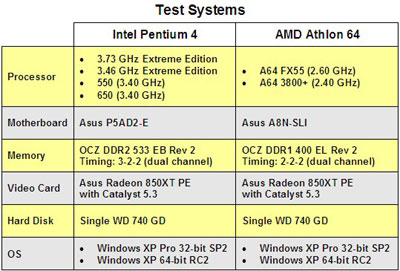
Memory timings are a matter of concern when benchmarking DDR2 based systems. The reader will find a wide range of timings in such test reports: From 3-2-2-8 to 4-4-14 - and in some cases timings are not even reported. At the same time DDR1 is usually tested with the best available timings of 2-2-2. Such aggressive timings are naturally giving an AMD system running at DDR1 an advantage when compared with an Intel system running at DDR2 4-4-4. We donít see any reason to neuter a DDR2 system by using unnecessarily conservative timings. Applications can perform up to 5% better when using DDR2 running at 3-2-2 instead of 3-3-3 as we have recently shown. The difference between 3-2-2 and 4-4-4 could be anywhere between 5% and 10%. Intel has specified the 925XE chipset to run at DDR2 CAS 3 and even first generation DDR2 is indeed capable of running CAS 3 at 533 MHz. We tested our Intel and AMD platforms at the best of their capabilities with both systems running in dual channel DDR1 at 2-2-2 and dual channel DDR2 at 3-2-2. The latter are representing the best currently available, manufacturer specified timings for DDR2 533. The same goes for the chipsets and motherboards we were using. The Intel 925XE chipset is the only chipset that supports a 1066 MHz system bus and represents currently the fastest platform for LGA 775 Prescott. The same holds true for the nForce4 chipset when it comes to socket 939 A64.
TEMPERATURE:
Until now Prescott came in 2 versions: an 84 Watt variant and another one consuming 115 Watts. Prescott processors above 3.40 GHz belonged to the 115 Watt group with a so-called "platform requirement bit 1" or PRB=1 and the models below that speed belonged to the 84 Watt group with "platform requirement bit 0" or PRB=0. The difference is in the current/voltage characteristic. The situation has now somewhat changed with the 6xx series and the N0 stepping. The 650 clocked at 3.40 GHz belongs to the lower heat dissipating 84 Watt PRB=0 group, which will make this processor an interesting choice for heat sensitive environments. Because of the higher number of transistors on the die, the 6xx series should in general dissipate more heat than the 5xx series. But the "Thermal Design Power" Intel giving for both series is not indicating anything like this. We have to point out that the values in the TDP chart are somewhat misleading. The TDP values Intel is specifying are not actually the maximum power dissipation but instead are targets for cooling design. AMD however gives the maximum power a processor is dissipating under worst conditions. Tests have shown that comparable Intel values would be 10% to 15% higher to be comparable with AMDís TDP values - or the other way around.
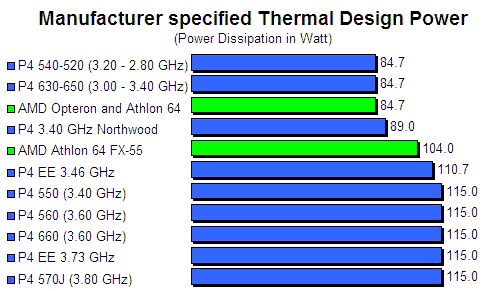
How is the newly implemented "Enhanced Speed Step" working? All following temperature values are taken with the Intel provided LGA stock HSF, case ventilation with 2x 80 mm fans, and an ambient temperature of around 26C. When idling 6xx series processors are running at 2.80 GHz with the multiplier dropped to 14x. We tested a 660 (3.60 GHz) from the high power dissipating PRB=1 group, and found it idling at 2.80 GHz at around 42 C. This is around 5C less than what we are used from first generation Prescott processors. EIST is supposed to work not only in idle but under light load as well. We could not trigger such a transition between various multipliers although we tried several "light load" jobs and tried several power schemes. The 660 would either stay at 14 x 200 MHz = 2.80 GHz or went back to the stock frequency of 18 x 200 MHz = 3.60 GHz. To simulate the most demanding thermal situation we let the system crunch SETI@home for a while and found the CPU temperature hovering just below 70C.
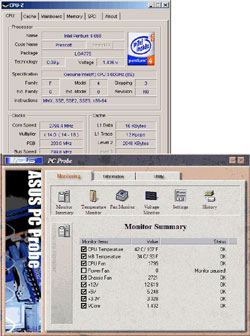
The 3.73 GHz EE has the disadvantage that EIST is not available with this processor, because the multiplier cannot be dropped below 14 x. Consequently the 3.73 GHz EE is always running at its stock frequency of 14 x 260 MHz = 3.73 GHz. Unfortunately, but not surprising the idle temperature hovered around 50C, much higher than on regular 6xx processors that have EIST implemented. Under load the 3.73 GHz EE temperature reached 71 C.
|
|
Advertisement:
All original content copyright James Rolfe.
All rights reserved. No reproduction allowed without written permission.
Interested in advertising on OCAU? Contact us for info.
|

|


